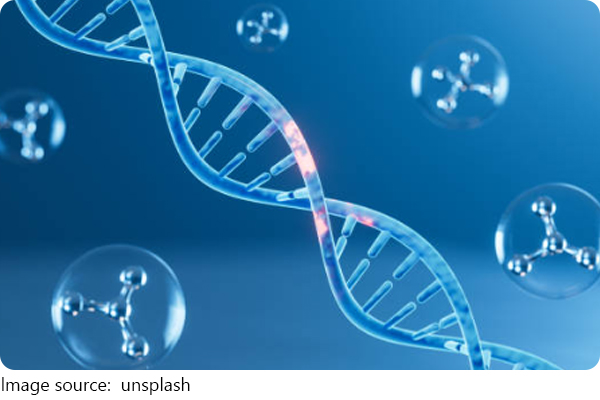Genes Hold Secrets Inside!

Genes are specific sequences of nucleotides within DNA that serve as biological instructions.
These instructions guide the synthesis of proteins—molecules responsible for nearly every cellular function in the human body.
Whether determining the color of a person's eyes or regulating immune responses, genes are fundamental to both the visible traits and internal operations of an individual.
Each human cell contains approximately 20,000 to 25,000 protein-coding genes, housed within 23 pairs of chromosomes. Although these genes account for only 1–2% of the genome, they orchestrate countless physiological functions. The rest of the genome, once dismissed as "junk DNA," is now recognized for its role in gene regulation and chromatin structure.
Genes and Disease: The Medical Relevance
Genes are not just biological markers; they are often the origin of disease. Mutations—alterations in the nucleotide sequence—can impair or entirely disrupt gene function. For example, a point mutation in the HBB gene leads to sickle cell anemia, while expansions in the HTT gene cause Huntington's disease.
According to Dr. Kári Stefánsson, CEO of deCODE Genetics, "Every complex disorder—whether it's schizophrenia, diabetes, or heart disease—carries a genetic architecture that we're just beginning to decode." Recent studies published in Nature Genetics have uncovered polygenic risk scores for cardiovascular conditions, allowing clinicians to assess an individual's genetic predisposition with increasing precision.
In oncology, somatic gene mutations in TP53, BRCA1, and KRAS guide both prognosis and therapeutic options. For instance, BRCA mutations in cancer patients inform the use of PARP inhibitors, a class of targeted therapy aimed at exploiting tumor DNA repair weaknesses.

Genetic Expression and Regulation
The presence of a gene does not guarantee its expression. Gene expression is controlled through various mechanisms, including transcription factors, epigenetic modifications (such as DNA methylation), and non-coding RNAs. These mechanisms determine which genes are turned "on" or "off" in specific tissues at precise times.
Recent advances in single-cell RNA sequencing (scRNA-seq) have made it possible to map gene expression at the cellular level, revolutionizing our understanding of tissue-specific pathologies like glioblastoma or autoimmune vasculitis.
Epigenetics: When the Environment Talks to Genes
The interplay between genes and environment is mediated by epigenetics—heritable changes that do not alter the DNA sequence but influence gene activity. Exposure to trauma, chronic inflammation, or even nutrition can trigger epigenetic changes that persist across generations.
For example, prenatal exposure to famine has been linked to methylation changes in the IGF2 gene, altering metabolic function in descendants decades later. Such findings suggest that disease susceptibility can be shaped not just by DNA but by lived experience.
Clinical Applications: From Genomics to Precision Medicine
The utility of genetic knowledge in medicine is rapidly expanding. Whole-genome sequencing (WGS) and whole-exome sequencing (WES) are becoming standard tools in rare disease diagnosis. A 2024 consensus from the American College of Medical Genetics recommends early sequencing in pediatric cases where standard diagnostics have failed.
In pharmacogenomics, patient-specific genetic data guide drug selection and dosing. Variants in CYP2C19, for example, determine whether a patient can effectively metabolize clopidogrel—a critical factor in preventing post-stent thrombosis. Similarly, HLA-B*15:02 screening prevents life-threatening reactions to carbamazepine in Southeast Asian populations.
Ethical and Social Considerations in Genetic Medicine
The integration of genetic testing into clinical practice raises ethical dilemmas around privacy, discrimination, and consent. The Genetic Information Nondiscrimination Act (GINA) in the U.S. prohibits genetic-based employment or insurance discrimination, but gaps remain, especially in areas such as life insurance underwriting.
Moreover, direct-to-consumer genetic testing services—while popular—pose risks of misinterpretation and psychological distress without proper genetic counseling. Experts like Dr. Laura Hercher, a genetic counselor at Sarah Lawrence College, warn that "raw data without context can do more harm than good, especially in anxiety-prone populations."

The Future of Genetic Medicine
Emerging gene-editing tools such as CRISPR-Cas9 have shifted the paradigm from observation to intervention. Clinical trials using CRISPR to correct the CFTR gene in cystic fibrosis or to delete BCL11A in sickle cell disease are underway, with preliminary results showing promise. Nonetheless, off-target effects and ethical boundaries remain points of contention.
Synthetic biology and gene drives may eventually be used to control vector-borne diseases like malaria, while AI-based gene mapping could accelerate drug development pipelines. As we step into an era where genes can be read, edited, and even designed, the physician's role in navigating this complex terrain becomes even more critical.
Genes are the language in which biology writes its instructions, its warnings, and its opportunities. Far from being static blueprints, they are dynamic instruments influenced by time, environment, and intervention. In clinical practice, understanding gene function is no longer optional—it is essential to diagnostics, therapeutics, and the promise of personalized medicine.
-
 Rise of Green Finance!Is Green Finance Just Hype Or The Future Of Wealth?! See What's Driving This Money Movement Now!
Rise of Green Finance!Is Green Finance Just Hype Or The Future Of Wealth?! See What's Driving This Money Movement Now! -
 Age Shields: Immune Power!Can Strong Immunity Really Slow Down Aging?! The Answer Might Change Clinical Aging Views!
Age Shields: Immune Power!Can Strong Immunity Really Slow Down Aging?! The Answer Might Change Clinical Aging Views! -
 Gen Z & Millennials Rise?Are Young Investors Winning The Game?! New Rules, Bold Moves, Or Financial Chaos? Find Out!
Gen Z & Millennials Rise?Are Young Investors Winning The Game?! New Rules, Bold Moves, Or Financial Chaos? Find Out!